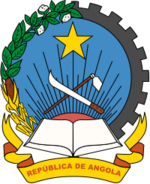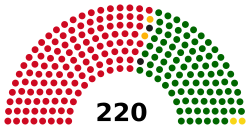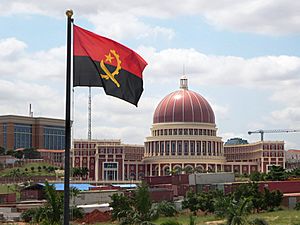National Assembly (Angola) facts for kids
Quick facts for kids National AssemblyAssembleia Nacional |
|
|---|---|
| 5th National Assembly | |
 |
|
| Type | |
| Type | |
| Houses | National Assembly |
| History | |
| Founded | 1980 |
| Leadership | |
|
President of the National Assembly
|
Carolina Cerqueira, MPLA
Since 16 September 2022 |
|
Secretary General
|
Pedro Neri, MPLA
|
| Structure | |
| Seats | 220 |
 |
|
|
National Assembly political groups
|
Government (124)
Official opposition (90)
Other parties (6)
|
| Elections | |
|
National Assembly voting system
|
Closed-list proportional representation |
|
National Assembly last election
|
24 August 2022 |
|
National Assembly next election
|
2027 |
| Meeting place | |
 |
|
| National Assembly building in Luanda | |
The National Assembly (Portuguese: Assembleia Nacional) is the main law-making body of the government in Angola. Angola has a unicameral system, which means the National Assembly is the only group that makes national laws. The People's Movement for the Liberation of Angola (MPLA) party has been the largest group in the Assembly since Angola became independent in 1975.
For many years, multi-party elections were not held in Angola. The first multi-party election happened in 1992. After that, another election was not held until 2008 because of a civil war. A new constitution was put in place in 2010. The first election under this new constitution took place in 2012.
Contents
How Members Are Elected
The National Assembly has 220 members. These members are chosen in two ways. Ninety members are elected from 18 different areas, called constituencies. Each of these areas elects five members. This is done using a system called party-list proportional representation.
The other 130 members are chosen based on how many votes each party gets across the whole country. This also uses a proportional representation system. The goal is to make sure that the number of seats a party gets is similar to the percentage of votes it received.
What the Assembly Does
The National Assembly is part of Angola's government. The government has three main parts: the President and Vice-Presidents (executive), the National Assembly (legislative), and the courts (judicial).
The National Assembly's main job is to create and approve laws for the country. It also helps to oversee the government's actions. Because of past civil wars, the President has often held a lot of power. The Assembly has different groups, called committees, that help it do its work every day.
The Assembly Buildings
The first building for the National Assembly, which was then called the People's Assembly, was in a cinema in Luanda. This was back in 1980.
A new, much larger building for the National Assembly was started in 2009 and finished in 2015. It is part of a big area in Luanda that also includes the Presidential Palace and other government offices. The new Assembly building is very large, with 4,600 seats in total. It has many meeting rooms and a large underground parking area. This modern building helps the Assembly do its important work for Angola.
Political Parties in the Assembly
The MPLA has been the main party in the National Assembly since Angola gained independence in 1975. For a time, Angola was a one-party state, meaning only the MPLA was allowed.
In 1991, an agreement was signed to allow many political parties. The first multi-party election was held in 1992. In that election, the UNITA party won 70 seats in the Assembly. However, in later elections, like in 2008 and 2012, UNITA won fewer seats. The MPLA continued to win the most seats, showing its strong support in the country. The most recent election was in 2022.
See also
 In Spanish: Asamblea Nacional de Angola para niños
In Spanish: Asamblea Nacional de Angola para niños
- List of presidents of the National Assembly of Angola
- Politics of Angola
- List of legislatures by country

